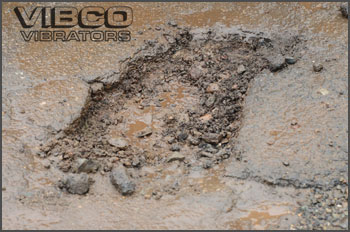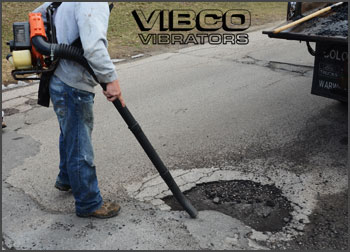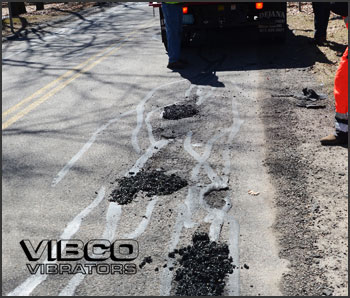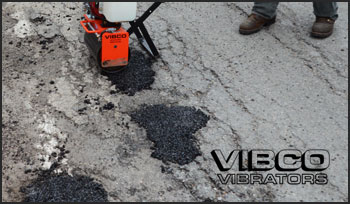by
[user not found]
| Jul 14, 2014
Potholes are a major problem throughout the United States and around the world. Reports come in daily from Idaho to Michigan from England to Washington DC about the problems potholes are creating for cities and towns.
Cities and towns spend thousands of dollars every year on pothole repair - often repairing the SAME potholes week after week, year after year.

VIBCO has been educating our customers on proper pothole repair technique and procedure for many years, but this is the first time we're presenting the actual pothole repair process. The bottom line is that repairing a pothole "the VIBCO Way" is easy - it just takes the right tools and a few minutes. When done correctly, you will never have to go back to the same pothole again. Ever.
So how do you fix a pothole for good?
Start with understanding what's NOT working… and then commit to a new method.
Throw-and-roll. Hand tamping. Those are quick and easy methods, but the repairs just don't last. You've seen the asphalt "crumbs" all over the road as cars and water ruin these temporary patches… sometimes within hours of the "repair".
"But that's how it's always been done!"
"We have all these holes to fill - we don't have time to do anything else!"
"That's what you do with cold patch."
That's like saying, "But we've always used Oxen to plow our fields!" or "We have all these handwritten logs we've done - we can't switch to a spreadsheet!" or "Printed photos are easy to send via postal mail - why do I need Facebook or Instagram?"
Change is sometimes uncomfortable. We get that. But when a better method - a CHEAPER, FASTER, BETTER method comes along that gives you what you WANT, not just what you GET… you have to commit to the new method. That's how we do more with our limited resources. It's where innovation, improvement, and progress begin.
That being said, here are the correct steps required for a long lasting, properly fixed pothole:
1. Clean the Pothole
This is an extremely important step that most online guides miss. They don't even address the need to prepare the hole for repair - they just begin with actually applying the patch or asphalt to the pothole. Patching a hole that is filled with water and/or debris virtually guarantees the patch will lift, disintegrate, etc. So be sure to Clean the Pothole!

Method: Clean the pothole with a large shop broom or a leaf blower. The goal is to get the pothole so that there is no loose debris inside of the hole or loose material hanging off the sides of the pothole that could hinder the patch or asphalt from sealing correctly and preventing water and the elements from creeping under the patch.
2. Fill the Pothole with Patch Material
Regardless of if you're using hot asphalt patch or cold asphalt patch to repair your pothole, there are some key points to remember.

Method:
- Mound the patch material in the hole
- Using a lute, rake the patch material so that you can see the edges of the hole and material does not overflow the hole.
- Where there is uneveness, make it a priority to take excess patch from one part of the pothole and spread it to the sections that need it. An even material spread will pay dividends later on in the repair process and in the long term life of the repair job.
3. Compact The Patch Material
There are different ways to compact pothole repairs. From the least effective - the "roll" part of "throw and roll" to the most effective - a roller compactor.

Regardless of the tool and process you use, the goal of flattening out the patch is so that it not only is flat, but that the patch blends in with the road, doesn't collect rainwater, doesn't get kicked up by tires, and doesn't create a hazard for motorists.
There are some proper practices to bear in mind when flattening a pothole:
- Apply even pressure to the entire mound of patch
- Work from the outside and move inward
- After each sweep of the flattening tool, scrape away the excess material and re-pack it into the pothole
- If your device has a screed bar, use that bar to shave off lumps or domes and, again, work the excess material back into the pothole patch.
The goal of the process should be a flat patch that doesn't dome up or resemble a birdbath [8]
4. Clean Up
This is another extremely important step that is often neglected in the "how-to" guides.
Once you've packed your pothole, take a shop broom or a leaf blower and clean away the loose asphalt around the pothole. Sweep it off to one side and collect it or sweep the loose crumbs onto the pothole and pack it into the patch. Either way, make a point to remove the loose debris from on and around the pothole. Leaving loose debris and patch material is unsightly and creates a hazard on the road.
5. Say goodbye to this pothole for good and move on!
Your pothole is now repaired for good… so say goodbye because you won't be returning to fix it again.
By committing to a new method - by following these steps - cities and town will save tens of thousands of dollars in pothole repair costs. Going back to the same hole over and over again is wasteful, frustrating, and ultimately costs much more than fixing the hole correctly right from the start.
If you're looking for more information on pothole repair, check out this video:
And if you're looking for some material and tools to fix your pothole with, consider some of these links and resources:
Patch: